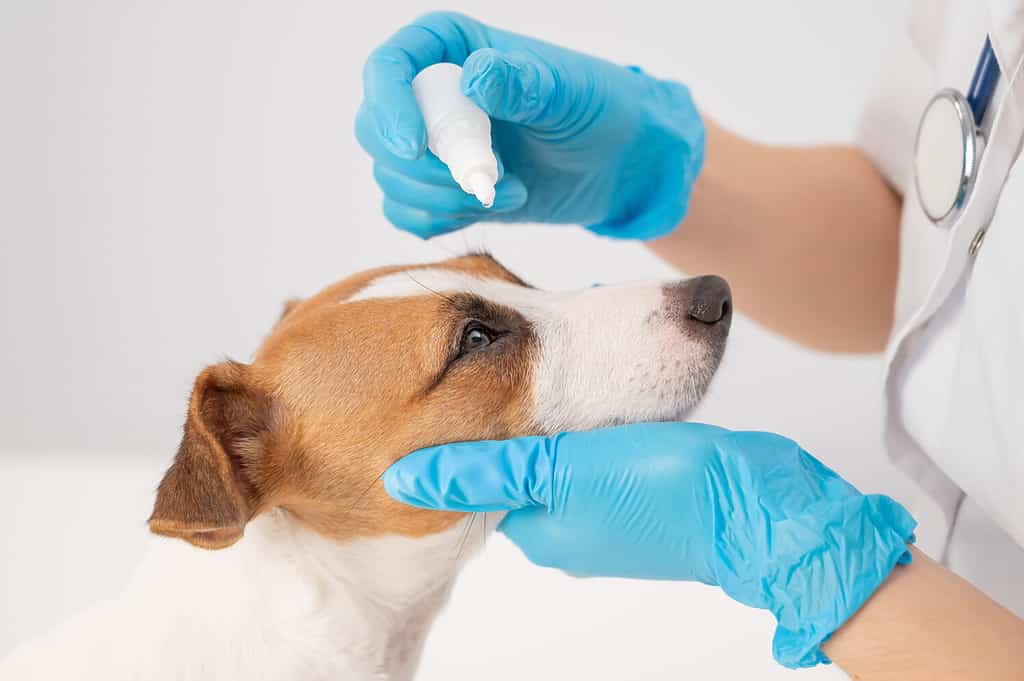Both dogs and people can suffer from vision problems, such as cataracts, especially as we age. Fortunately, your dog’s cataracts can be treated successfully with surgery. Read on to find out why your dog might need cataract surgery, what the typical prices are, and some tips on saving money on the cost of the surgery.
Cataracts in Dogs

As people and dogs age, they are more likely to develop cataracts.
©selvaco/Shutterstock.com
Cataracts are a clouding of the lens of the eye, causing a person or dog’s vision to seem blurry. It can make the world appear as if you are seeing things through the surface of a foggy window. For people, cataracts can affect vision and make it hard to do things like reading or driving. According to the Mayo Clinic, as the cataracts grow, the clouding gets worse. Cataracts are usually slow to change but can worsen over time and may lead to eventual blindness.
What Are Typical Prices of Dog Cataract Surgery in 2024?
According to the financial website MarketWatch, dog cataract surgery in 2024 can run between $2,700 to $4,000. The total cost will depend on many factors, such as the severity of the cataracts, whether your dog needs surgery in one or both eyes, and medication prices. Prices also vary based on your local veterinary’s charges. Areas with a higher cost of living will have higher vet bills from the surgery.
In addition to the cataract removal, the following are some treatments your vet may require along with the surgery:
- Consultation appointments
- Physical exams and bloodwork
- Eye ultrasound
- General anesthetic
- Artificial intraocular lens implantation
How Does Cataract Surgery Work in Dogs?

Cataract surgery removes the lens of the dog’s eye.
©Reshetnikov_art/Shutterstock.com
Cataract removal surgery is called phacoemulsification. The vet makes small incisions in the cornea and then uses a process that destroys the lens, allowing the vet to remove the entire lens with a vacuum. Next, an artificial lens is inserted and the vet closes the cornea with tiny sutures. Most of the time, these will be dissolvable stitches that absorb into the eye in a few weeks and do not need to be removed.
According to the Cornell University College of Veterinary Medicine, it’s better to perform surgery during the early stages of cataracts because as the cataracts advance, other complications can occur. However, your vet can discuss the benefits and risks for your particular dog’s situation. For example, cataract surgery may not be recommended in senior dogs when general anesthesia can be risky.
5 Ways to Save on Your Dog’s Cataract Surgery
Once you and your vet have decided cataract surgery is the best option for your dog, be sure you are given a written estimate of the total costs. As we mentioned above, cataract surgery can be expensive, up to $4,000. The price depends on a variety of factors including the severity of the cataracts and your area’s cost of living. However, there are some ways you may be able to save money on your dog’s surgery.
1. Pet Insurance
You may want to consider investing in pet insurance to help lessen the cost of surgery. However, if your dog has already been diagnosed with cataracts this may not be a viable option. Unfortunately, it will be hard (or impossible )to find a pet insurance company that covers pre-existing conditions.
2. Get a Second Opinion
Although you will need to pay for the consultation, another vet may lower prices or offer another treatment plan for your dog that isn’t as costly, while still giving your dog the best care.
3. Apply for a Grant or Financial Fund
Depending on your financial circumstances, you may be able to find a healthcare fund to help you pay for your dog’s treatment.
- RedRover publishes lists of resources for urgent care grants and other financial assistance programs. Banfield Foundation also publishes a list of resources of nonprofit organizations that help pet owners.
- You may also be able to find specific breed financial help (RedRover has a resource list for specific breeds.)
- The Humane Society has a list of resources to help owners struggling to pay vet bills as well.
- Veterinary colleges may offer financial assistance programs or grants.
4. Your Vet for Help
Don’t hesitate to ask your veterinarian for help. They may offer payment plans, financial assistance, or know of resources to help you cover your dog’s surgery bills. Your vet’s office may offer a line of credit through a provider, such as CareCredit. You may be able to find low-interest financing options that will be much less expensive than paying the high-interest rate on a credit card. Sometimes you can find deals with no interest or very low interest if you pay the bill off by a certain amount of time.
5. Prevention
Although you can’t prevent cataracts in dogs when they are hereditary or happen from old age, some causes of cataracts can be prevented. Cataracts can begin in dogs that have developed diabetes from a poor diet high in carbohydrates. Feeding your dog a good diet and giving him plenty of exercise will go a long way to keeping your pet healthy. It’s also good to get your dog’s eyes regularly checked out by your vet. An early diagnosis of cataracts can let you begin treatment right away which can help lower costs in the long term.
Ready to discover the top 10 cutest dog breeds in the entire world?
How about the fastest dogs, the largest dogs and those that are -- quite frankly -- just the kindest dogs on the planet? Each day, AZ Animals sends out lists just like this to our thousands of email subscribers. And the best part? It's FREE. Join today by entering your email below.
Thank you for reading! Have some feedback for us? Contact the AZ Animals editorial team.








